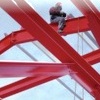
Six Degrees of Hand Vibration
Several types of gloves are effective in lessening vibration exposure. The standard hierarchy of controls is the right way to proceed against this common hazard.
- By Andy Olson
- Mar 01, 2010
Hands are critical for our lives and our work.
The ability to grasp, hold and manipulate tools and objects with strength and dexterity is critical to our everyday lives and especially to our work. It is what sets us apart from most other creatures. Common phrases referring to "manual labor" and "being handy" recognize the central place our hands play in work.
However, because of their vital role in our working lives, hands are also vulnerable to injury. Thus, it's not surprising that protecting hands is a fundamental part of most workplace safety programs. Most people focus on cut, slash, or puncture protection, but there is another all-too-common hazard in many occupations: vibration.
Vibration Exposure
Exposure to hand and arm vibration is a familiar reality for the modern worker in a wide variety of tasks. The list is long and includes riveting, grinding and sanding, deburring, demolition, drilling and mining, oil and gas refining, heavy construction, assembly and fabrication, and chainsaw and jackhammer work. Exposure can be prolonged and severe in these occupations and can lead to discomfort and disability. Over time, it also can result in the serious condition known as Hand/Arm Vibration Syndrome (HAVS). HAVS can cause permanent numbness and damage to the hands and arms and has been estimated to affect one in 10 people who work regularly with vibrating tools.1
More widespread, however, is exposure to "nuisance vibration." Nuisance vibration, while not as severe as that caused by heavy equipment or vibrating tools, can give workers a "tingling" sensation in their hands and arms. While this sensation usually subsides shortly after exposure to the vibration stops, it is a concern for those using smaller tools, driving automobiles or buses, doing repair work on certain types of machinery, and in numerous other applications. The result is often worker discomfort and decreased productivity.
Exacerbations to both HAVS and the effects of nuisance vibration include cold temperatures, damp environments, and nicotine use.
Protecting Our Hands
Engineering controls are always the preferred method for hand injury prevention. Designing work environments, equipment, and tasks so that workers' hands are never placed in jeopardy is the best approach. However, this is not always possible, especially when workers are engaged in construction, assembly, disassembly, or repair tasks that require extreme handling.
Training, work practices, and administrative controls are also effective in keeping workers' hands out of danger zones. However, this can be difficult when addressing vibration reduction because the operation of vibrating tools frequently requires workers to operate the tools with their hands. Therefore, the combination of a "hands off" policy is most effective when supplemented with the proper personal protective equipment (PPE).
Various PPE solutions are available to combat both severe and nuisance vibration. The governing standard (ANSI S3.40-2002/ISO 10819:1996) designates performance criteria that certify compliant gloves as vibration-reducing (VR). In order to comply with this standard, gloves must be full-fingered, must use a polymer or pad of uniform thickness, must not amplify mid-range vibration frequencies, and must reduce high-range frequencies by 40 percent versus a bare hand. Gloves that meet this standard are vital in situations where workers are exposed to severe vibration. However, their full-finger design and traditionally thicker palm padding limit finger dexterity and make them less desirable for more detailed work.
Other hand protection options are available for workers exposed to less severe, nuisance vibration. For example, an "impact glove" is a common style featuring a padded leather palm. In addition to protecting workers' hands from the impact of a blow to the palm, their padded palms also provide protection from nuisance vibration. Typically of a half-finger design, impact gloves allow for excellent finger dexterity to perform common tasks.
Additionally, some "trades" or "mechanic" style gloves feature gel polymers in portions of the palm that provide some protection from mild to moderate vibration. These gloves are typically more dexterous and breathable than impact gloves because they are made of lighter materials. They also are available in more functional designs, including full, three-quarter, or half-finger options.
The Bottom Line
Exposure to hand and arm vibration in the workplace can range from severe and debilitating to nuisance and productivity sapping. Fortunately, there are simple solutions to this under-reported, under-regulated problem. Follow the hierarchy of controls to eliminate or reduce risk as much as reasonably possible. However, when engineering or administrative controls are not possible abatement approaches -— or when you want to augment their effectiveness —- then using appropriate certified or quality non-certified hand protection is a cost-effective option. Whatever the task or level of exposure, there is likely a hand protection solution available to reduce the vibration and allow the worker to focus on doing his job effectively and safely.
Reference
1. http://www.patient.co.uk/health/Hand-Arm-Vibration-Syndrome.htm